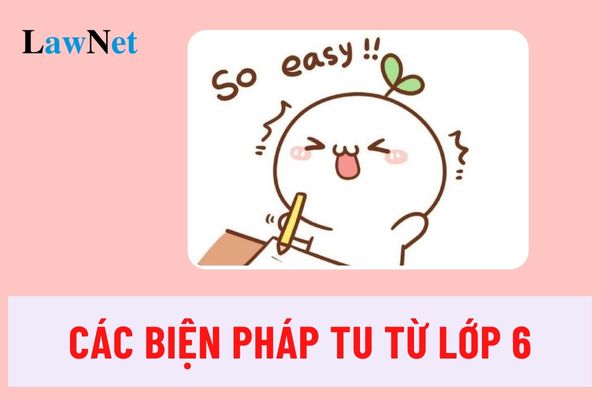What rhetorical devices are taught to grade 6 students in Vietnam?
What rhetorical devices are taught to grade 6 students in Vietnam?
According to Subsection 2, Section 5 of the General Education Curriculum for Literature, issued with Circular 32/2018/TT-BGDDT, Grade 6 students will be exposed to the following Vietnamese Language knowledge content after studying the Literature subject:
- Simple words and compound words, compound and reduplicative words
- Polysemous words and homophones
- Meanings of some common idioms
- Meanings of some common Sino-Vietnamese elements (e.g., bất, phi) and meanings of words containing those elements (e.g., bất công, bất đồng, phi nghĩa, phi lí)
- Main components of sentences: expanding main components with phrases- Adverbial particularly: characteristics, connective function in sentences)
- Uses of the semicolon (to mark the boundaries between complex listed items); quotation marks (to mark words not used in their usual sense)
- Rhetorical devices of metaphor and metonymy: characteristics and effects
- Paragraphs and texts: characteristics and functions
- Selecting appropriate words and some sentence structures to convey the meaning of the text
- Text types and genres
+ Narrative text: writing an essay recounting a personal experience, a story retelling a folk tale
+ Descriptive text: writing an essay describing an activity
+ Expressive text: six-eight poetry; a paragraph expressing feelings when reading six-eight poetry
+ Argumentative text: opinions, reasons, evidence; an essay presenting an opinion on an event in studying or life
+ Informational text: headline, lead, subheadings, bold text, bullets, and numbering; an explanatory text recounting an event; minutes of meetings or discussions
- Language development: borrowing words, borrowed words, using borrowed words- Non-verbal communication aids: images, data
** Grade 6 rhetorical devices include 2 types: metaphor and metonymy.**

What rhetorical devices are taught to grade 6 students in Vietnam? (Image from the Internet)
What are examples of rhetorical devices in grade 6 in Vietnam? How to differentiate them?
(1) Example of metaphor
Based on similarities in shape:
"The sun sets slowly behind the green bamboo fence" ("Mặt trời lặn dần sau lũy tre xanh") (Comparing the setting sun to a round ball slowly descending behind a fence).
"She has eyes that can speak" ("Cô ấy có đôi mắt biết nói") (Comparing eyes to the ability to convey emotions).
Based on color similarity:
"Red flames light up the entire sky" ("Lửa hồng rực rỡ cả một góc trời") ("Lửa hồng rực rỡ cả một góc trời") (Comparing the red color of the flame to that of roses).
Based on material similarity:
"Her voice is like velvet" ("Giọng nói của cô ấy như nhung") (Comparing the soft, gentle voice to the material velvet).
Based on function similarity:
"He is my solid support" ("Anh là chỗ dựa vững chắc của em) (Comparing a partner to a sturdy object).
(2) Example of metonymy
Using a part to denote the whole:
"One thatched roof, two golden hearts" ("Một mái nhà tranh, hai trái tim vàng") (Roof refers to the house, hearts refer to people).
"Several yellow leaves float down" ("Mấy chiếc lá vàng rơi lả tả") (Yellow leaves refer to the entire tree).
Using container to denote the contained:
"My whole family loves drinking tea" ("Cả nhà tôi đều thích uống trà") (Tea referring to the tea beverage).
Using a sign to refer to the thing signified:
"Green forest with lush leaves" ("Rừng xanh lá tốt") (Lush leaves referring to trees).
Using the concrete to denote the abstract:
"Youth is the spring of the country" ("Tuổi trẻ là mùa xuân của đất nước") (Spring referring to a beautiful, vibrant period).
(3) How to differentiate between metaphor and metonymy
Metaphor: Based on similarities between two objects or phenomena. There is an implicit comparison.
Metonymy: Based on the close relationship or association between two objects or phenomena. There is no comparison.
What are additional literature knowledge for Grade 6 students in Vietnam?
According to Subsection 2, Section 5 of the General Education Curriculum for Literature, issued with Circular 32/2018/TT-BGDDT, additional literature knowledge for Grade 6 students includes:
- Expressiveness of literary texts
- Details and the relationship between details in literary texts
- Subjects, themes of the texts; emotions, feelings of the author
- Elements: plot, characters, narrative voice and character dialogue in legends, fairy tales, fables
- First-person and third-person narrators
- Structural features of six-eight poetry: number of syllables, lines, rhyme, rhythm
- Title, lines, stanzas, rhyme, rhythm, wording and the use of these elements in poems
- Narrative, descriptive elements in poetry
- Note-taking forms, recounting events, first-person narration in memoirs or travelogue
Additionally, reading materials used in Grade 6 Literature include:
(1) Literary texts
- Legends, fairy tales, fables, short stories
- Poems, six-eight poetry
- Memoirs or travelogue
(2) Argumentative texts
- Social argumentation
- Literary argumentation
(3) Informational texts
- Texts recounting an event
- Minutes of meetings
- Diagrams summarizing content

